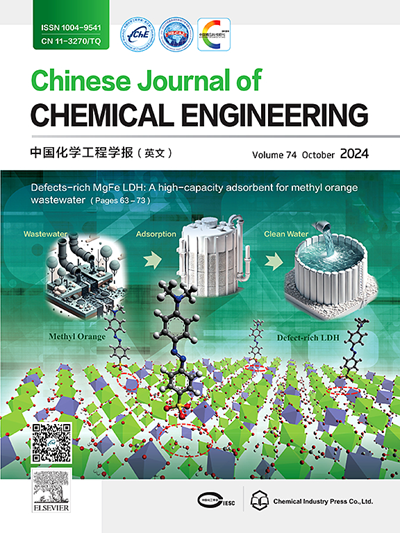相平衡法分离卤尾液中氯-溴基固溶体
IF 3.7
3区 工程技术
Q2 ENGINEERING, CHEMICAL
引用次数: 0
摘要
固溶体的存在阻碍了卤水中溴资源的提取。为分离卤尾液中的氯-溴基固溶体,采用等温溶解法测定了四元体系KCl-KBr-NaCl-NaBr-H2O及其三元体系NaBr-KBr-H2O在333.15 K时的溶解度,并绘制了相图。采用改进的模型预测了KCl-KBr-NaCl-NaBr-H2O四元体系在333.15 K时的溶解度。计算结果与实验值吻合,表明该预测方法是可行的。提出了从卤尾液中分离氯溴基固溶体的闭环结晶工艺,获得了纯度为98.23%的NaBr。本文章由计算机程序翻译,如有差异,请以英文原文为准。

Separation of chlorine–bromine-based solid solution in bittern tail solution by phase equilibrium
Solid solution hinders the extraction of bromine resources from bittern. To separate chlorine–bromine-based solid solution in bittern tail solution, the solubilities of the quaternary system KCl–KBr–NaCl–NaBr–H2O and its ternary subsystem NaBr–KBr–H2O at 333.15 K were determined by the isothermal dissolution method, and the corresponding phase diagrams were conducted. An improved model was employed to predict the solubilities of the quaternary system KCl–KBr–NaCl–NaBr–H2O at 333.15 K. The calculated results coincide with the experimental values, implying that the prediction method is feasible. A closed loop crystallization process for the separation of chlorine–bromine-based solid solution in bittern tail solution was proposed and NaBr was obtained with a purity of 98.23%.
求助全文
通过发布文献求助,成功后即可免费获取论文全文。
去求助
来源期刊

Chinese Journal of Chemical Engineering
工程技术-工程:化工
CiteScore
6.60
自引率
5.30%
发文量
4309
审稿时长
31 days
期刊介绍:
The Chinese Journal of Chemical Engineering (Monthly, started in 1982) is the official journal of the Chemical Industry and Engineering Society of China and published by the Chemical Industry Press Co. Ltd. The aim of the journal is to develop the international exchange of scientific and technical information in the field of chemical engineering. It publishes original research papers that cover the major advancements and achievements in chemical engineering in China as well as some articles from overseas contributors.
The topics of journal include chemical engineering, chemical technology, biochemical engineering, energy and environmental engineering and other relevant fields. Papers are published on the basis of their relevance to theoretical research, practical application or potential uses in the industry as Research Papers, Communications, Reviews and Perspectives. Prominent domestic and overseas chemical experts and scholars have been invited to form an International Advisory Board and the Editorial Committee. It enjoys recognition among Chinese academia and industry as a reliable source of information of what is going on in chemical engineering research, both domestic and abroad.
 求助内容:
求助内容: 应助结果提醒方式:
应助结果提醒方式:


